Contents
The variety of Dutch selection Vikoda gardeners called the noble strawberry. The culture adapts to difficult climatic conditions, without ceasing to bear large fruits. Vikoda strawberry tolerates frosty winters and hot summers, only during drought requires abundant watering.
Main characteristics
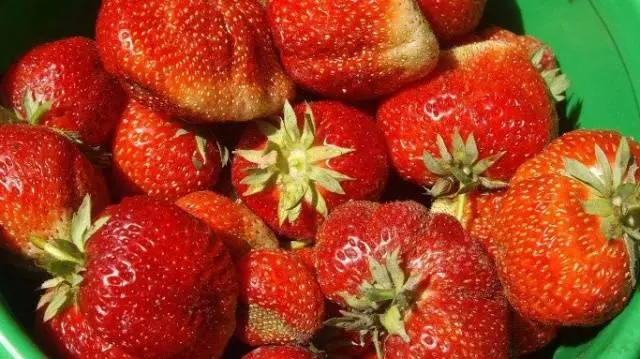
Considering the description of the Vikoda strawberry variety, photos, reviews, you should first dwell on the characteristics of the culture. Dutch breeders in the process of crossing obtained strawberries with excellent taste. A powerful lush bush grows of medium height. Strong shoots are able to hold berries with an average weight of 50–70 g. The Vikoda variety was not in vain called noble. The first fruits grow weighing about 120 g.
Despite its gigantic size, the inside of the berry is dense. The pulp is juicy, tender with a cherry flavor. When eating strawberries, acidity is clearly felt, but there is also enough sweetness. The berry has a spherical shape. On large fruits, ribbing with irregularities is observed. Vikoda is considered a late variety. Harvesting starts at the end of July.
Distinctive features of the variety
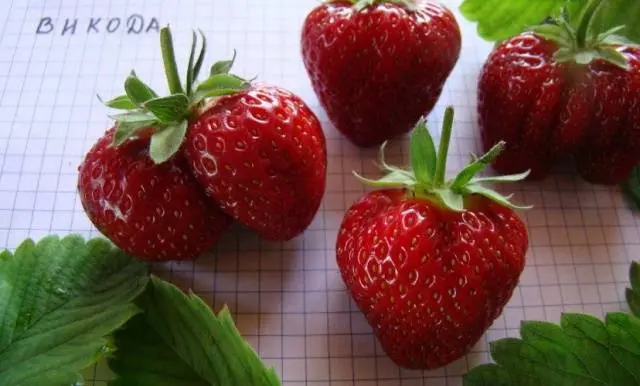
To get to know the Vikoda strawberry variety better, it is worth considering the distinctive features:
- The first large fruits rarely grow at once with an even shape. Usually the berry is flattened. There are double fruits. By the time of ripening, many berries are able to restore the spherical shape characteristic of the variety.
- The readiness of strawberries for harvesting is signaled by the white color of the tip against the background of bright red pulp. The berry is easily detached from the sepals and in this state is able to be stored or transported without loss of presentation.
- The aroma of ripe cherries is felt not only when eating berries. A pleasant smell stands over a clearing with ripe strawberries.
- The variety is not affected by putrefactive bacteria. Spotting rarely appears on the leaves.
Advantages emphasize the superiority of Vikoda strawberries over other varieties:
- a bush brings about 1 kg of berries per season;
- strawberries do not freeze out in winter even with poor shelter;
- large fruits are not loose, which allows the use of strawberries in culinary dishes, for freezing, juicing, preservation.
The disadvantage is the demand for free space for growing Vikoda. To get a high yield of large berries, the bushes are planted far from each other, which is problematic in small areas. Another disadvantage is the violation of the consistency of the berry when exposed to extreme heat.
Soil preparation and seedlings

According to gardeners, Vikoda strawberries love soil of medium acidity. It is optimal to bring the pH to a value of 5–6,5. Purchased seedlings are in no hurry to send to the garden. First, the plants are hardened, taking them outside during the day. If seedlings are planted under a film, it is enough to keep them in a cool place for at least two days. Hardening will help the Vikoda variety to quickly adapt to the external environment.
When preparing new Vikoda seedlings, do not rush to uproot all the old strawberries. Only a part of the bushes is removed from the garden in a checkerboard pattern. You should get a scheme according to which a young Vikoda is surrounded by old strawberries. Large bushes with broad foliage will protect new plantings from the wind.
Rules for preparing the beds
Before planting Vikoda strawberries, you need to properly prepare the bed. The rules are simple and there are only four of them:
- A bed for the spring planting of Vikoda strawberries is being prepared in the fall. The process involves digging the soil and applying organic fertilizers: humus, manure or compost. For autumn planting, the bed is dug up for a month or at least two weeks.
- Strawberries do not like extreme heat, but the Vikoda variety loves the sun. To improve the taste and accelerate the ripening of berries, a garden bed is laid out on the sunny side of the site.
- Vikoda loves feeding. It is especially important to apply fertilizer to get large berries. Organic components are applied at the rate of 5 kg per 1 m2 beds. Mineral fertilizer is enough for about 40 g.
- Vikoda strawberries love frequent weeding and are afraid of weeds. The soil in the garden is kept loose so that oxygen enters the roots.
Following simple rules for preparing and caring for the garden will help you grow a good strawberry crop.
Rules for planting and growing
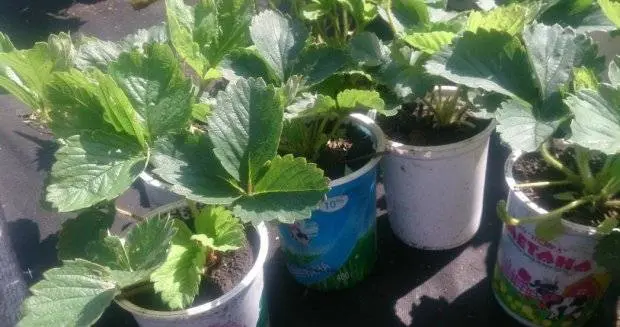
Before planting, the seedlings are once again subjected to a thorough inspection. Only strong plants are selected, and all weak ones are thrown away. Productive strawberry seedlings are determined by the following features:
- the minimum thickness of the root neck is 7 mm;
- the bush has an intact upper bud and at least three full leaves;
- fibrous root system about 7 cm long.
Prepared Vikoda seedlings are planted according to the following rules:
- Strawberries are planted at least a month before the expected frost. You cannot shorten the time. Seedlings should have time to take root and take root well.
- For planting the Vikoda strawberry variety, a cloudy but warm day is chosen. In sunny weather, it is difficult for plants to take root. Strawberries will have to be shaded by installing additional shelters.
- A bed for strawberries is broken in rows. Row spacing is at least 40 cm. Holes for each bush are dug at a distance of 50–60 cm from each other.
- Before planting a seedling, the soil inside the hole is moistened with water. The hole is made wide so that the root system is freely located. Strawberry seedlings are sprinkled with earth to the level of the neck of the root. This place in the strawberry is the point of growth, and it should be located above the ground.
- After planting the seedling, the ground around the bush is lightly pressed by hand. The plant is watered abundantly, and after the water has been absorbed, the soil inside the hole is mulched with humus.
Variety Vikoda favorably perceives watering. A lot of water is required during the formation of berries.
Features of variety care
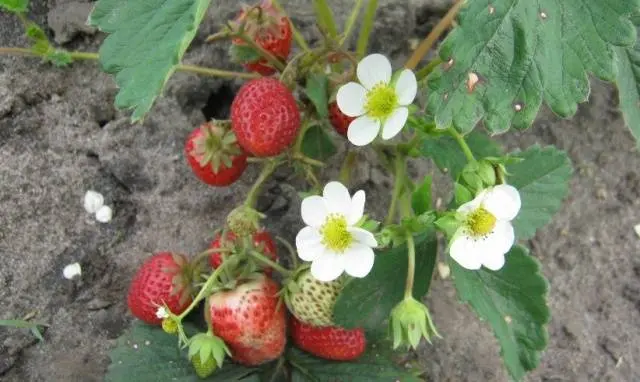
Considering the description of the Vikoda strawberry variety, photos, reviews of gardeners, it is worth paying attention to the rules for caring for the crop. Often the simplest mistakes lead to the death of an entire strawberry plantation.
spring work
Strawberries need a quick start in spring. The first rule of care is frequent loosening of the soil and timely watering. Vikoda loves water. The intensity of watering is regulated according to weather conditions, but at least 1-2 times a week.
Top dressing is carried out every spring month. In March, the bushes are poured with a solution of chicken manure. However, nitrogen cannot be overdone. The solution is prepared from a glass of litter, infused for three days in 10 liters of water. 0,5 l of liquid is poured under each plant.
From the beginning of April, mineral complexes begin to be introduced. Use a mixture of saltpeter with ammophos 1: 2 or prepare a solution from a glass of wood ash and 10 liters of water. Organic fertilizing is organized in May. Dissolve two glasses of manure in 10 liters of water. Each bush under the root is watered with 1 liter of liquid. Dry manure can simply be scattered on the ground.
Summer work
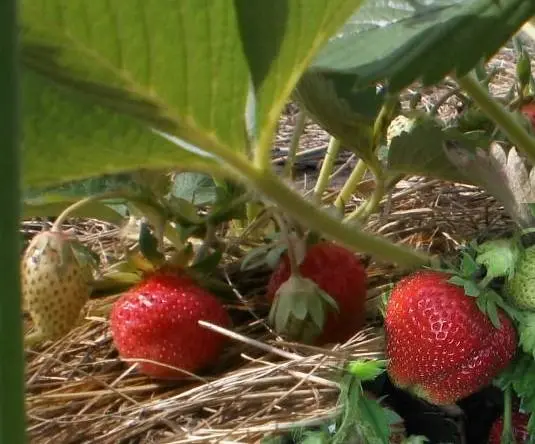
Summer care is associated with regular watering up to four times a week, weeding, adding sand around the bushes during the formation of berries. Fertilize with sulfate before each bloom. After harvesting the berries, Vikoda is fertilized with an ash solution.
Autumn work
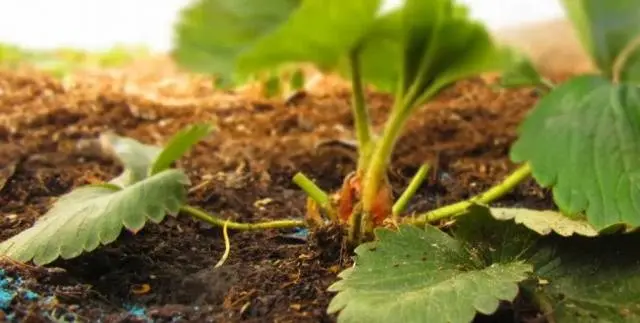
Before the onset of frost in the fall, Vikoda is watered a maximum of twice a week. Feed along with water. Fresh manure at this time of the year is undesirable to use. The bed will become infected with parasites.
In autumn, foliage, extra mustaches are cut from the bushes. The roots washed with water are sprinkled with earth. Closer to frost, the beds are mulched with fallen leaves, straw, or covered with needles. For the winter, plantings are covered with spruce or pine branches. The needles hold the snow well, forming a warm blanket over the strawberries.
Harvest
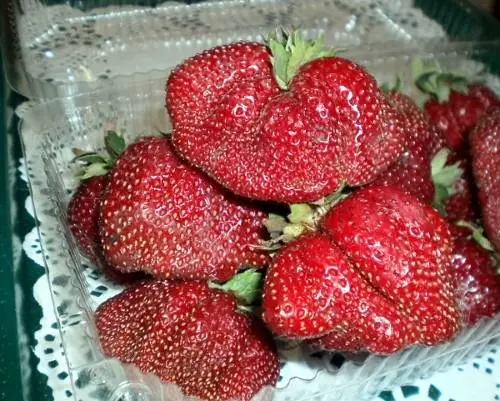
Ripe strawberries are quite tender. Harvesting and preserving a crop is sometimes more difficult than growing. It is better to pick berries for storage a few days before full ripening. At this time, the nose of the fetus is still white with a greenish tinge. Picked berries will ripen, thereby extending the shelf life.
During harvesting, it is desirable to sort the fruits. Large berries are juicy and do not go to storage. They are best eaten or processed immediately. Small fruits are harvested for storage.
Berries of Vikoda are well separated from the stalk and are stored well in this form. However, this method cannot be called the best. Harvest lasts longer with whole stalks. Time for harvesting is allocated in the morning after the dew has dried. In the evening, strawberries are picked before sunset.
Store plucked berries in boxes in one layer. The bottom of the container is covered with paper. After picking the berries and packing in boxes, it is advisable to cool the strawberries faster to a temperature of 0 to +2оC. Quickly chilled crop will lie in the refrigerator for up to four days.
In the video, a gardening company talks about growing strawberries:
Reviews
It is better to help to learn about the Vikoda strawberry variety reviews of gardeners.









